Expansion/Breakaway Collars
There are numerous designs for expansion and/or breakaway collars for use on wildlife, some published in biological literature and others not. Many designs have been used successfully; however, each design also has limitations. Collars designed for one species or used successfully in one environment may or may not work well on other species or in different areas. In the case of juvenile animals the neck circumference increases and then remains constant, so the elastic or other expansion material need only expand once. In contrast, collars used on males that undergo "rut" should be able to expand then return to their original size, which can be more difficult.
Collars designed to stretch or expand may be more likely than static collars to be slipped off an animal’s neck. Such collars may also allow an animal to slip a leg through the collar and become entangled, or the collar might become snagged on something in the environment more easily than a static collar. Such concerns should be addressed by the study team prior to deciding on use of expandable and/or breakaway collars. Telonics recommends that researchers considering use of this type of collar consult with individuals who have experience with the design and species of interest. Careful monitoring of animals that wear expansion collars is also recommended.
Several types of expansion/breakaway collars that Telonics has produced are described below. We also are able to work with you on custom expansion and/or breakaway collars. All designs described below are for use with Telonics transmitters; the collars or expansion/breakaway mechanisms are not sold separately.
For additional information, please see Telonics' Technical Note: Breakaway Collars, Timed Collar Releases, and Expansion Collars.
Those interested in precisely timed collar releases should reference the information on Telonics programmable collar releases.
Expansion/Breakaway Collar Options
Designs used on juvenile ungulates
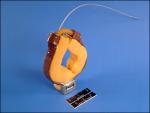 |
CB-1 Breakaway Collar: This collar was designed for newborn deer and antelope fawns. It has also been used on mountain goat kids. The collar is made of preformed Kydex with a "teardrop" shape, and ~3.5-inch diameter. It is held together with latex tubing that can be tensioned to various amounts. The tubing degrades over time with exposure to solar radiation. When the tubing is sufficiently weakened the collar is released. Release typically occurs at 4-10 months depending on growth rates and environmental conditions. Foam padding inside the Kydex allows for neck growth prior to breakaway. Attachment hardware is not used with this design which is slipped over the head of the animal for deployment. This collar has typically been used with the MOD-300 or smaller VHF transmitters. |
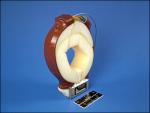 |
CB-2 Breakaway Collar: This collar is similar to the CB-1 but is slightly larger for older deer and antelope fawns. The collar is made of preformed Kydex in an oval shape and ~4 X 5.5-inch dimensions. It is held together with latex tubing that can be tensioned to various amounts. The tubing degrades over time with exposure to solar raditation. When the tubing is sufficiently weakened the collar is released. Release typically occurs at 6-14 months depending on growth rates and environmental conditions. Foam padding inside the Kydex allows for neck growth prior to breakaway. Attachment hardware is not used with this design which is slipped over the head of the animal for deployment. This collar has typically been used with the MOD-300, MOD-400 or similar-size VHF transmitters. |
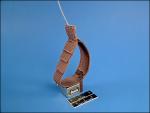 |
CB-4 Expansion and Breakaway Collar: This collar was designed to expand with neck growth on caribou occupying open environments. It has also been used on deer, Dall sheep, and cougar kittens. The elastic material allows expansion of ~30% due to the elasticity of the material, and the collar has three flaps of material that are sewn with different amounts of stitching to provide further, three-stage expansion. Attachment hardware is not used with this design which is slipped over the head of the animal for deployment. This collar has typically been used with the MOD-200, MOD-300, or similarly-size VHF transmitters. |
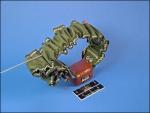 |
CB-5 Expansion Collar: This collar designed for juvenile ungulates uses nylon reinforced elastic within an expandable sleeve. Versions of this collar have been used on deer, elk, moose, bighorn sheep, and ibex, with the length of elastic and sleeve differing between various applications. In some applications portions of the elastic and sleeving have been sewn into loops to allow additional overall expansion, up to about double the initial size. The collar is available in several colors. It was originally used with MOD-200 and MOD-300 size transmitters, but has been used with larger configurations up to the MOD-500. |
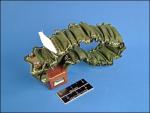 |
CB-6 Expansion and Breakaway Collar: The design of this collar is similar to the CB-5 described above however; the collar incorporates a breakaway section. Cotton stitching on the breakaway tab degrades over time to allow the collar to separate and fall away. As with the CB-5, details of collar size have varied, and the design has been used on deer, mountain goat, moose, and stone sheep. This collar has typically been used with the MOD-200, MOD-300, or similarly sized VHF transmitters. |
Designs involving modifications of static belting collars for larger mammals to provide limited expansion or breakaway
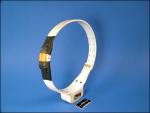 |
CB-3A Breakaway Collar: This breakaway collar was designed for larger mammals. It involves a modification to static Telonics collars (e.g. CMM or CLM), where the collar is cut, and then the two sections are reattached using latex tubing. This does not allow for neck expansion, but does provide a mechanism whereby collars eventually fall off the animal. Breakaway times are dependent upon species, climate, habitat, and physical stress or abrasion. The attachment tubing can be covered with heat shrink tubing, tape or other material to extend the life of the attachment. For larger collars this type of breakaway has largely been replaced by the CR-2a, CR-5, and CR-7 timed release mechanisms. Versions of the CR-3 collar have been used on white-tailed deer, muntjac, black bear, chimpanzee, snow leopard, and tayra. |
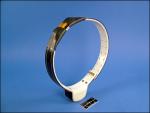 |
CB-3B Breakaway Collar: The CB-3B is a similar design to the CB-3A but with the addition of a stitched elastic breakaway tab to slightly extend the period prior to breakaway, and to allow slight expansion of the collar. For larger collars this type of breakaway has largely been replaced by the CR-2a, CR-5, and CR-7 timed release mechanisms. Versions of the CR-3 collar have been used on white-tailed deer, muntjac, black bear, chimpanzee, snow leopard, and tayra. |
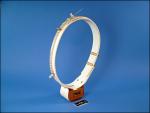 
 |
CB-8 Expansion Collar: This collar was designed for moose, and different adjustment ranges and collar width (2 & 3 inches) have been used on various ages and sexes of moose and caribou. The collar is constructed of static belting, but with a sliding tab tensioned by a bungee cord inside a tubing sleeve. This design has been used with the MOD-600 VHF transmitter and with several satellite-linked GPS collars. |
Designs used on felid and ursid cubs
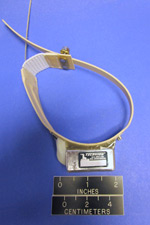 |
CB-12 Expandable Collar: This collar is a modified version of the design described in Higgins-Vashon, J. et al. 2003. An expandable collar for black bear cubs. Wildlife Society Bulletin 31(2):380-386. It has been used with the MOD-105 VHF transmitter on black bear cubs. Expansion is provided by both a section of elastic that expands from ~1-inch to ~2-inches, and by a section of collar that is clamped to a critical tension by the user when deployed using HD000463-001 hardware. |
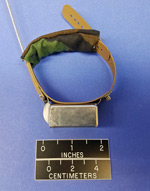 |
CB-13 Expandable Collar: This collar design was modified from similar collar built by a researcher and used on mountain lion kittens in the western US for years. It is designed to be put on kittens at about 4 weeks old, and to expand to fit animals up to about 6 months of age. The design includes a section of elastic folded and stitched down to ~7 cm length. Including the non-expandable portion of the collar, the collar can be put on animals with neck circumferences from ~17 - 25 cm and it can expand up to ~42 – 50 cm depending on which adjustment holes were used when fitted to the kitten. The collar should be fitted somewhat loosely at first because the kittens grow quickly, but snug enough to not easily fall off. Users should note that dexterous species such as cats can remove expandable collars and this can be especially true when interacting with their siblings. |
Expansion and breakaway inserts for collars
 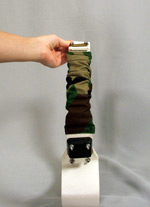 |
CB-9 Expansion Section: This expandable insert can be added to 2-inch wide Telonics collars. One piece of HD000460-001 collar hardware is provided with the expansion section (the other end is fastened with hardware provided with the main collar). The section is ~8-inches between attachment holes when contracted and ~12-inches when expanded. (The second photo shows the CB-9 installed on a collar which also includes a CR-2a collar release mechanism.) |
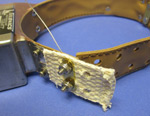 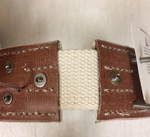 |
CB-10 Cotton Breakaway Insert: A section of cotton webbing is sometimes used as a breakaway, with the size and attachment method depending on collar size and design. Time to breakaway can be highly variable depending on species and environment; thus, for larger collars this type of breakaway has largely been replaced by programmable collar releases. However, for some smaller collars where the size and weight of the timed release mechanisms is not practical, such cotton inserts offer an option if inclusion of a breakaway function is viewed as important. Depending on the application, the CB-10 cotton section can either be a separate piece that is attached using standard collar hardware or sewn in as an integral part of the collar. These inserts can be provided as part of a Telonics collar, but are not sold separately. |
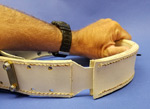 |
CB-11 Expandable Insert: This collar insert has been used on juvenile tapir. Overall length of the insert is 20 inches, with the expansion section 8.5 inches and providing 4 inches of expansion, and the rest of the collar providing 11.5 inches of adjustment for initial fitting to the animal. A layer of static belting slides between a sleeve of belting and is tensioned using bungee cord. The insert is attached to an appropriate Telonics collar using two pieces of HD000461-001 hardware. |
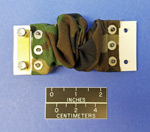 |
CB-14 Expandable Insert: This insert is similar to the CB-9, except it uses springs rather than elastic to provide the expansion. This design is more suitable than the CB-9 for rutting animals because the springs better return to original size following expansion for a period of time. This insert can be added to 2-inch wide Telonics collars. One piece of HD000460-001 collar hardware is provided with the expansion insert (the other end is fastened with hardware provided with the main collar). This insert normally provides ~5 inches of expansion (from ~4 inches to ~9 inches between attachment points). |


















